Billund is a small town in Denmark, famous for being the birthplace of LEGO, the world's most popular toy brand. The town is also home to the original LEGOLAND theme park, which attracts millions of visitors every year. However, Billund is more than just a LEGO paradise - it is also a vibrant and innovative community, with a rich cultural and natural heritage.

Above: Billund. The large white building to the right of the centre of the photograph is Lego House. More about this further down the webpage.
Billund was founded in the 16th century as a village of farmers and craftsmen. It remained a rural and quiet place until the 1930’s, when Ole Kirk Christiansen, a carpenter, started making wooden toys in his workshop. His son, Godtfred, invented the LEGO brick in 1958, and the rest is history. Today, LEGO is one of the largest and most successful companies in Denmark, and Billund is its headquarters.

Above: LEGO Corporate Headquarters. The larger-than-life minifigure outside the front of the modern building’s main entrance is the same character used in the Up-Scaled LEGO Minifigure set (set number 40649), which was released in June 2023.
Billund is not only a place for LEGO fans, but also for anyone who loves creativity, learning and fun. The town offers a variety of attractions and activities for all ages and interests. Visitors can explore the history and culture of Billund at the Museum of Local History, the Billund Art Museum and the Sculpture Park. For fans of outdoor activities and/or nature and wildlife, there is Gyttegård Golf Course, the Grene Sande Nature Reserve, and the Lalandia Aquadome. Visitors can also experience the innovation and education of Billund at the International School of Billund, the LEGO House and the LEGO Education Innovation Studio.

Above: View of the centre of Billund, as seen from Lego House
Billund is a town that celebrates its past, present and future. It is a town that inspires imagination, curiosity and joy. It is a town that welcomes all of its visitors to discover its wonders and secrets. Some of the places visited during a trip to the town in late March 2023 follow on this webpage, as does a brief history of The Lego Group.
 |
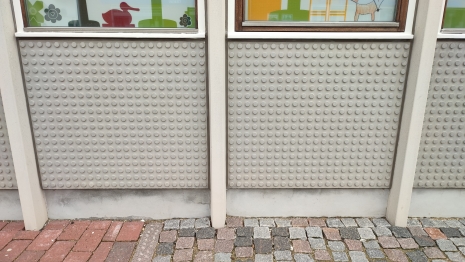 |
Above: Architectural detail on the side of the Lego Idea House. Not to be confused with Lego House, Lego Idea House is a museum of Lego history just for Lego Group employees and is not open to the general public. Better send my CV/Resume off!
LEGOLAND
LEGOLAND Billund is a theme park that celebrates the creativity and imagination of Lego bricks. Visitors can explore different themed areas, such as Pirate Land, Adventure Land, and Lego City, where on display are amazing Lego models, thrilling rides to go on, and a variety of interactive activities. LEGOLAND is also home to the original Lego factory, where visitors can learn about the history and production of Lego products. Whether a Lego fan or not, LEGOLAND is a place where families and children of all ages can have a memorable and enjoyable time.

Above: Main entrance to LEGOLAND Billund, Denmark's most famous and popular amusement park for families and children of all ages. The visit here was out of season when the park was closed, and in any event, the main purpose of this trip was to visit Lego House (open all year round, except for a few closing days). Being from England, it was felt that perhaps a visit to LEGOLAND Windsor may be something to plan in the future.
LEGOLAND Billund was the first such theme park to open and remained the only one in the world from when it opened in 1968 until 1996. Since then, other LEGOLAND’s have opened across the world, and as of the time of writing, a list of these follows:
□ LEGOLAND Billund Resort in Denmark, the original and oldest LEGOLAND
park (opened 1968)
□ LEGOLAND Windsor Resort in England, the
largest LEGOLAND park in terms of area (opened 1996)
□ LEGOLAND Deutschland Resort in Germany, inc. MINILAND with scenes from
German and European cities (opened 2002)
□ LEGOLAND Dubai in the United Arab Emirates, the first LEGOLAND park in
the Middle East (opened 2016)
□ LEGOLAND Malaysia Resort in Malaysia, the first LEGOLAND park in Asia
(opened 2012)
□ LEGOLAND Japan Resort in Japan, the second LEGOLAND park in Asia
(opened 2017)
□ LEGOLAND California Resort in the United States, the first LEGOLAND
park outside Europe (opened 1999)
□ LEGOLAND Florida Resort in the United States, the largest LEGOLAND
park in terms of number of attractions (opened 2011)
□ LEGOLAND New York Resort in the United States (opened 2021)
□ LEGOLAND Korea Resort, the first and only LEGOLAND on an island
(opened 2022)
In addition to the above, there are some 24 (and rising) LEGOLAND Discovery Centres located in various (mainly) cities around the world; smaller versions of the LEGOLAND theme parks, these are indoor family attractions, operated by British leisure group Merlin Entertainments, featuring Lego-themed models and attractions. Furthermore, there is a LEGOLAND Water Park located inside Gardaland theme park in Italy.

Lego House
The main of this visit to Billund was to take a look around Lego House. Lego House is a unique architectural project that celebrates the creativity and innovation of Lego bricks. The building is designed to look like a stack of Lego bricks, with colourful façades and playful shapes. The interior of Lego House is filled with interactive exhibits, galleries, and workshops that invite visitors to explore the history and possibilities of Lego. Lego House is not only a museum, but also a learning centre, a playground, and a meeting place for Lego fans of all ages. Lego House is a testament to the power of imagination and the joy of building.

Lego House (above) appeals not only to children, young and old, but also to anybody looking for a fun place to visit and especially to adult fans of LEGO (AFOLs). Exhibits showcase the history, culture and innovation of the Lego brand and its products. It is also a place to unleash creativity and imagination with millions of LEGO bricks.
Lego House opened in 2017 and covers an area of approximately 130,000 square feet (12,000m²). On the ground level is a large open foyer with public access to a few displays, general seating areas, a café (with Lego-themed décor and furniture), and a LEGO store (where there are some exclusive Lego sets and souvenirs that are only available in this LEGO store). Tickets can be purchased either for the day or for twice the amount, an annual pass. Tickets, which cover all zones and exhibits in the Lego House (available at the desk or paid for in advance online) are in the form of a wristband, enabling exit and re-entry throughout the day. The centrepiece of Lego House is the Tree of Creativity, a 15-meter tall sculpture made of over six million LEGO bricks that represents the growth and evolution of the LEGO brand. Over multiple levels are four coloured zones, each representing a different aspect of learning and play: red for creative skills, blue for cognitive skills, green for social skills, and yellow for emotional skills. Within each zone are find various interactive exhibits and activities that challenge visitors, young and old, to build, explore and collaborate with LEGO bricks. One of the highlights of Lego House is the Masterpiece Gallery, where visitors can admire amazing LEGO creations made by fans from around the world. In the basement, another interesting area is the History Collection, where it is possible to learn about the origins and development of LEGO from its humble beginnings as a wooden toy company to its global success as a plastic brick manufacturer.
At the time of writing, the Lego House is open every day from 10:00 to 18:00, except on some holidays. The Lego House is certainly a unique and creative experience with plenty to see and do here. Photos taken on the visit from the different areas are shown in the thumbnail gallery below (click on an image to enlarge):
A Brief History of LEGO
The Christiansen family is the founder of the LEGO Group, one of the most successful toy companies in the world. The story of how they turned a small carpentry workshop in Denmark into a global empire of plastic bricks is both inspiring and fascinating.
The LEGO story began in 1932, when Ole Kirk Christiansen, a master carpenter and joiner, started making wooden toys in his workshop in Billund, a small town in western Denmark. He named his company LEGO, which is derived from the Danish words "leg godt", meaning "play well". He believed that playing was essential for children's development and creativity. His son, Godtfred Kirk Christiansen, joined the business at the age of 12 and became his father's right-hand man.

Above: Near Lego House on the main street in Billund is Ole Kirk's Original House. It is known locally as the "Lion House", because of the stone lions on either side of the front door. He built his house in 1932 and it served as his home and workshop for many years. The house is now a museum that showcases the history and evolution of LEGO, as well as the life and legacy of Ole Kirk. Visitors can see original models, prototypes, and patents of LEGO products, as well as personal items and photos of Ole Kirk and his family. The house is also a tribute to the values and vision of Ole Kirk, who believed in the power of play and creativity.
In 1947, LEGO became the first company in Denmark to buy a plastic injection-moulding machine, which allowed them to produce more toys at a lower cost. One of the products they made was a plastic brick with studs on top and tubes on the bottom, which could be stacked and locked together. This was the precursor of the modern LEGO brick, which was patented in 1958; Godtfred Kirk Christiansen is credited with playing a pivotal role in the development of the Lego brick design and patented it. He created the “LEGO System in Play”, a system whereby all elements fit together, can be used in multiple ways, and can be built together. The LEGO brick was designed to be versatile and compatible, enabling endless possibilities for building and playing and the LEGO System in Play is the cornerstone of the LEGO construction toy.
The LEGO brick soon became a hit with children and adults alike, and the company expanded its product range to include different themes, colours, shapes and sizes. Some of the most popular themes were LEGO Town/City, LEGO Space, LEGO Castle, LEGO Pirates and LEGO Technic. The company also introduced minifigures in 1978, which are small human-like characters that can be customized and placed in different scenarios. Minifigures added more personality and fun to the LEGO sets. They have become such a popular part of the brand globally that in fact the total number produced to-date is comparable to the world’s human population.
The Christiansen family remained in charge of the LEGO Group for four generations, until 2004, when Kjeld Kirk Kristiansen, the grandson of Ole Kirk Christiansen, stepped down as CEO and appointed Jørgen Vig Knudstorp as his successor. Knudstorp was the first non-family member to lead the company, and he faced many challenges such as declining sales, rising costs and increasing competition. He implemented a turnaround strategy that focused on innovation, quality and customer satisfaction. He also launched new initiatives such as LEGO Mindstorms, LEGO Education, LEGO Digital Designer and LEGO Ideas.
Today, the LEGO Group is still owned by the Christiansen family through their holding company, Kirkbi A/S. The company has more than 19,000 employees worldwide and operates in over 140 countries. It produces more than 75 billion bricks every year and has sold over 600 billion bricks since its inception. It has also diversified into other areas such as video games, movies, theme parks, books and magazines. The LEGO brand is recognized as one of the most valuable and influential brands in the world. The Christiansen family has left an indelible mark on the toy industry and on millions of people who grew up playing with LEGO bricks. Their vision of creating a toy that stimulates imagination, creativity and learning has been realised and surpassed. They have shown that with passion, perseverance and innovation, anything is possible.
Family Grave of Ole Kirk Christiansen
The family grave of Ole Kirk Christiansen, the founder of the LEGO company, is located in Grene Churchyard, just outside the town of Billund, Denmark. Ole Kirk Christiansen (1891-1958) is buried in a plot along with his wife and some of his children and grandchildren. The cemetery is open to the public and visitors can pay their respects to the man who created one of the most popular and iconic toy companies in the world:
 |
||
 |
 |
|
Sculpture Park
Attempting to change the subject from Lego, for those looking for an inspiring stroll, the sculpture park in Billund makes for a pleasant visit. The park is a collaboration between the LEGO Group and the Danish Arts Foundation, and it features 17 sculptures made by artists from around the world. The sculptures are inspired by the LEGO brick, but they also explore themes such as creativity, play, innovation, and sustainability. The park is open to the public and free of charge, and it offers a great opportunity to enjoy art and nature in a beautiful setting. There are some excellent seating areas along the way, for those wishing to take some time out or eat a packed lunch.
 |
 |
|
 |
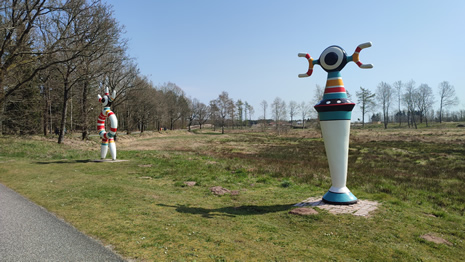 |
|
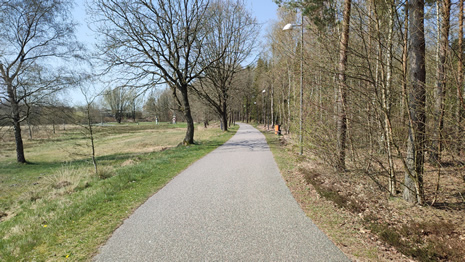 |
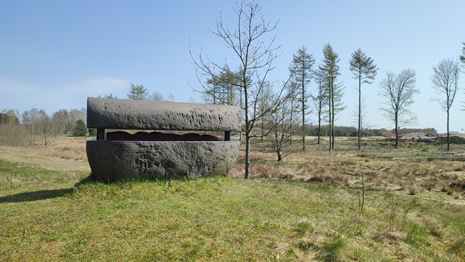 |
|
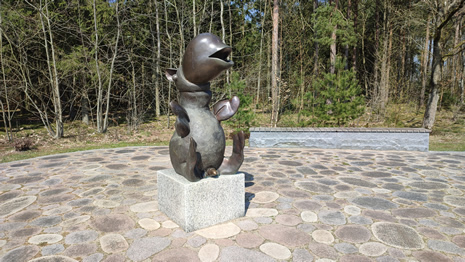 |
 |
Teddy Bear Art Museum
Not far from Lego House is the Teddy Bear Art Museum, home to more than 1200 teddy bears of different shapes, sizes, and origins. Visitors here can learn about the history and culture of teddy bears, as well as how they are made and collected. The museum also offers workshops, games, and a gift shop where teddy bear souvenirs can be purchased. The museum also includes a pleasant café which can be accessed without a ticket for the museum. Whether a teddy bear lover or just curious, this museum provides a unique experience.
The museum may also be of interest to lovers of modern architecture as it is located in the former home of Edith and Godtfred Kirk Christiansen. The house dates back to 1959 and was designed by architect Aage Bundgaard, Copenhagen. It was designed to be used both as a cosy family home, whilst also being a place where Godtfred Kirk Christiansen could receive business associates.
The Billund Centre
Whilst not a tourist site as such, a brief visit was made to have a look inside the Billund Centre (mainly for personal architectural interest). Located in front of the sculpture park, Billund Centre is a cultural centre located in the middle of the town. It was built in 1973 and was a gift from the Kirk Christiansen family and Ole Kirk's Foundation to Billund Municipality. The centre incorporates several facilities for local residents, including Billund Library, Billund Church, Citizen Service, Grene Parish history archive and Billund School of Culture. The library was redesigned by Rosan Bosch to provide a creative space for children to play and learn. It was completed in 2016 and, in the same year, was nominated for a Danish Design Award.
The Billund Centre functions as a gathering place for children and adults, young and old, and provides a social focal point; it’s the place where people can go to church, borrow a book or learn to play the drum and more. The lobby provides a spacious area to sit down, or perhaps take shelter if it is raining. Exhibitions take place here too, as well as meetings. Adjacent to the Billund Centre is the town’s central bus station, and Lego House is just a short walk away from here. The author of this webpage would like to add that, it is a shame there aren’t more multi-functional community buildings like this in the UK. It would perhaps bring more people together, regardless of whether they are churchgoers or not. Some photos below:
 |
 |
|
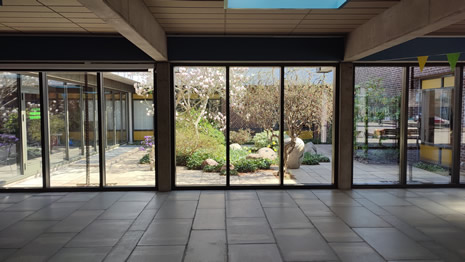 |
 |
|
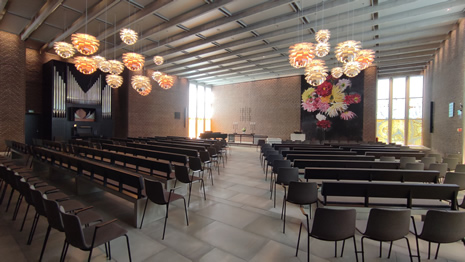 |
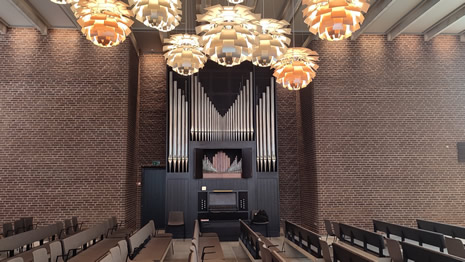 |
|
 |
||
Some Practicalities
There are various options for getting to and from Billund. The airport is only 2½ miles (4km) away from the city centre and there are direct flights from many European cities and slightly further afield (110 origin airports total, at the time of writing).

Above: Western end of Billund Airport
From the airport, a bus, taxi, or hire car can be taken, although in the case of this visit, because the weather was fine, the relatively short distance, and the author was travelling light, getting into the centre of Billund was simply by foot.
 |
 |
Above: Billund bus at the airport (left), and a LEGO bus (right) from set number 60335, Train Station (2022)
Billund does not have a train station. However, it is possible to take a train to Vejle, which is about 19 miles (30km) away from Billund. Vejle is well connected to other major cities in Denmark and Germany by rail. From Vejle, a bus or taxi can be taken to Billund. With a good European road network, driving here is an option for many. The roads are well maintained and signposted, and there are scenic views of the countryside along the way. However, drivers should be aware of the tolls and parking fees that may apply.

There are many options for accommodation in Billund, ranging from hotels and hostels to holiday homes and camping sites. It is worth booking ahead and being mindful that prices may be significantly higher than back at home, and choice of accommodation will naturally depend on budget, preferences and needs.
 |
 |
|
 |
 |
|
 |
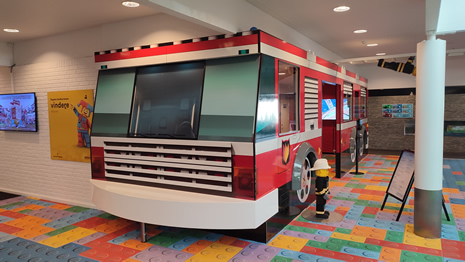 |
|
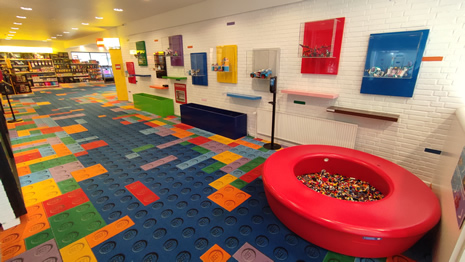 |
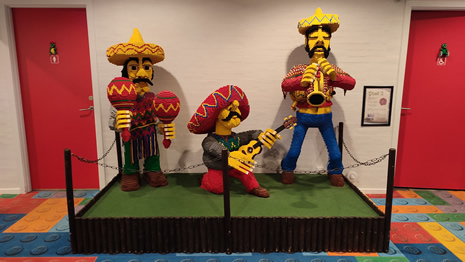 |
Above: LEGOLAND Hotel
There is a choice of hotels in the town centre or near the airport. Some of the most popular hotels in Billund are Hotel LEGOLAND, Hotel Propellen, Hotel Svanen and Zleep Hotel Billund. These hotels offer modern facilities, friendly service and easy access to the main attractions in Billund, such as LEGOLAND, Lalandia (Scandinavia’s largest waterpark, not featured on this webpage), and Lego House. The prices naturally vary depending on the season and the type of room.

Above: The fun continues into the evening, at LEGOLAND Castle Hotel
For a cheaper and more social option, there are a number of hostels in Billund. Hostels are a great way to meet other travellers and enjoy a cosy atmosphere. Some of the hostels in Billund are Danhostel Grindsted-Billund, Danhostel Givskud Zoo, and Danhostel Vejle. These hostels offer dorm beds or private rooms, shared bathrooms and kitchens, free Wi-Fi and common areas.

Above: The Bed & Breakfast where the author of this webpage stayed for one night. Being off-season, breakfast wasn’t being served, but the cabin-style room, complete with dining table and kitchenette was liked so much, it was decided to include their business card in the photo!
Holiday homes are available for rent in Billund or the surrounding area. These are ideal for families or groups who want to have their own kitchen, living room, garden and parking space. Many holiday homes in Billund can be found online (e.g. on Airbnb, Booking.com, or Novasol). The prices depend on the size, location and amenities of the holiday home.

Above: Netto supermarket in Billund. A handy stop if self-catering. Other grocery stores available.
For lovers of nature and adventure, one of the campsites in or near Billund is also an option. Campsites are a fun and affordable way to experience the outdoors and enjoy activities like hiking, biking or fishing. Some of the campsites in Billund are at LEGOLAND Holiday Village, Randbøldal Camping and Give Camping. These campsites offer pitches for tents, caravans or motorhomes, as well as cabins or cottages for rent. LEGOLAND Holiday Village also has a motel.

***
Note: Lego is a Registered Trademark of The LEGO Group, which does not sponsor, authorize, or endorse this webpage.
Back to Top